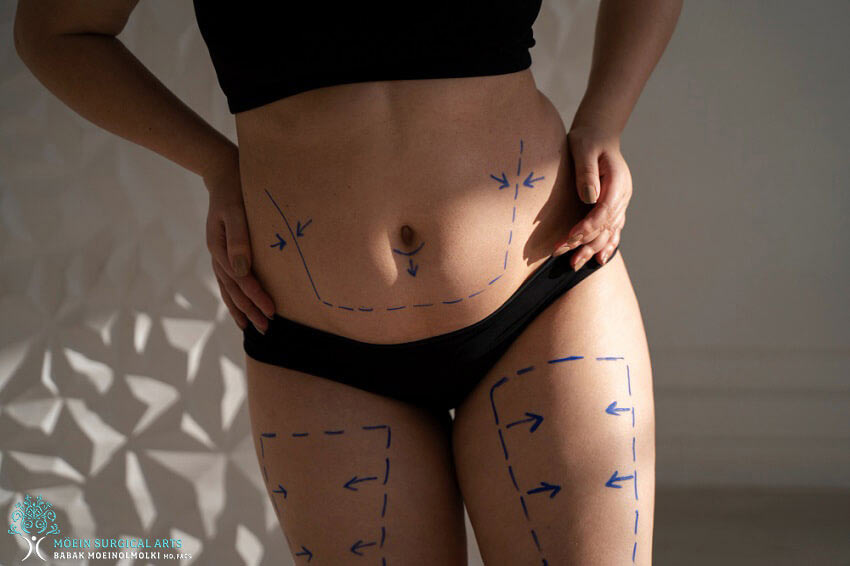
Revision cosmetic surgery is just what the doctor ordered if you experienced poor results with an earlier cosmetic technique. A common revision operation is breast augmentation where breast implants are replaced or rhinoplasty to correct a difficulty after surgery.
If you have experienced a negative result with previous cosmetic surgery or you failed to achieve the results you expected, a revision cosmetic operation by an experienced cosmetic surgeon can help.
In this post, we are going to discuss the several types of revision cosmetic surgery and why you stand to achieve superior results with a follow-up procedure. We will also talk about the fees involved and other information patients often ask about, including side effects, scarring, and the importance of choosing a skilled and highly trained cosmetic surgeon.
If you don’t want to wait until the end of the article to get your questions answered, be sure and call Moein Surgical Arts, home of renowned cosmetic surgeon Doctor Babak Moein in Los Angeles California at (310)455-8020.
In a perfect world, everyone who undergoes cosmetic surgery would love their results. The problem is we don’t live in a perfect world. Therefore, not everyone loves the results they achieve after waking up from anesthesia. This leaves patients with more problems than they had to begin with. Frustrating, right?
While poor results are not common, especially if you choose a board-certified cosmetic surgeon, there are times when you have the decision to make: Should you accept the results you got or find a different surgeon who can help you reverse the damage that has been done?
Revision cosmetic surgery is any surgery that is performed to correct problems related to a previous operation. Various follow-up techniques can help with excessive scarring, breast asymmetry, and functional issues (like nasal breathing) that may arise following your initial surgery.
Any patient who wants to fix issues that arise from previous cosmetic surgery is an excellent candidate for revision cosmetic surgery. Ideally, you will want to wait at least a year after the initial surgery before you undergo a follow-up operation. You should also be in relatively solid health with no untreated medical conditions. The cosmetic surgeon who performs the revision surgery will also prefer you to be a non-smoker since tobacco use can hinder healing and results.
The main signs you may require a surgical revision include:

Nearly any type of cosmetic surgery can be revised, though some types of revisions are more common than others. The most common types of cosmetic surgery revision include:
Patients tend to choose breast reduction due to insufficient reduction, and if the procedure fails to produce the aesthetic results the patient expected.
Breast reduction revision is usually performed due to asymmetry of the breasts and unsatisfactory appearance.
This revision cosmetic surgery is chosen due to insufficient reduction of the midsection, weight gain, and poor wound healing.
Patients may request this revision cosmetic surgery to create improved symmetry and restore breathing function.
Facelift revision can correct continued jowling, an unnatural appearance, and changes to the facial appearance following surgery.
Patients request facial implant revision to remove the implants entirely or to change the shape of the current implants.
Another frequently requested revision cosmetic surgery is one to correct a scar that has healed poorly. Bad scars can lead to unsightly deformities that can contribute to self-esteem issues. Scar revision surgery is a complex technique that involves camouflaging the appearance of the scar to make it less noticeable. It is not always possible to remove scars completely.
Read our article: Revision Cosmetic Surgery Can Restore Your Self-Esteem
Breast revision surgery is sought after for many reasons. Implants may be too big or small, and rippling or asymmetry may have occurred. Breast revision surgery involves the removal of the existing silicone or saline implant from the breast and replacing it with a new one.
Read our article: Breast Augmentation Trend: Smaller, More “Natural” Implants
Breast revision surgery may be necessary if you experience a loss of implant volume, if there is a ruptured implant, or if you have dissatisfaction with the implant size. A capsular contracture (tightening scar tissue), change in implant position, or stretching caused by weight gain may also necessitate breast implant revision surgery.
Breast revision surgery involves general anesthesia and one of two types of incisions.
During this revision surgery, horizontal incisions are made underneath the folds of the breasts.

For this breast revision surgery, incisions are made around the edge of the areolas. After the incisions are created, scar tissue is removed, and the old saline or silicone implants are taken out. The cosmetic surgeon will then insert new breast implants to provide you with an improved appearance.
For breast reduction revision, the cosmetic surgeon will use the old breast reduction scars to open the tissues to reposition the breast skin. In some instances, mild size differences between the breasts will warrant additional breast surgery. These size differences can also be managed with breast liposuction.
Revision abdominoplasty (tummy tuck) is performed similarly to the original procedure. There are slight variations, depending on the reason for the cosmetic revision. The goal of tummy tuck revision surgery is to create improved contours, lower the scar position (to make it easier to hide under clothing), and develop tighter abdominal muscles.
Contour problems can be repaired by removing areas of scar widening and through the use of liposuction.
Abdominal muscle repair can be performed within two months of the original tummy tuck surgery. The same incision is often used to access the muscles. The revision technique tends to be easier and less painful than the original operation, with a faster recovery as well.
For enlarged belly button scars that have enlarged, the revision technique involves the removal of belly button skin as well as the reshaping of the belly button area. A new belly button can be created if required.
Depending on what went wrong with the original rhinoplasty procedure, a revision rhinoplasty may be extremely complex. Alternatively, the technique may require a non-surgical option such as the fat transfer method or the skillful application of a dermal filler like Restylane.
The majority of rhinoplasty revisions involve the removal of residual cartilage or bone from the nose bridge. Some revisions are performed on individuals who have too much cartilage or bone removed, which results in a severe deformity. In these complex cases, the surgery may involve tissue grafts taken from the rib or ear to create the desired shape.
A facelift revision is usually needed because the wrong kind of procedure or technique was used in the first place. A skilled revision surgeon will use the proper technique and diligence to correct whatever went wrong. The ultimate goal of a revision facelift is to tighten the skin, remove visible scar tissue, and correct deformities such as jowly skin hanging on either side of the neck or under-eye sagging.
During the procedure, the incisions are created in the same location as the original facelift unless the scar tissue is unsightly. The muscles are tightened, excess skin is removed, skin is redraped, fat is relocated, and the incisions are closed.
The most common facial implant revision surgery involves the repositioning of cheek implants. The most common reason cheek implants are revised is due to improper position or migration of the implant following surgery. Cheek implants may be placed via an incision in the mouth, between the gums, or via an incision made in the lower eyelid.
The original incision is often used before the cheek implant is repositioned to the desired location. Another reason cheek implants are revised is because of the size and shape, whereby the new implant size or shape is chosen and implanted using the original incisions.
If a cheek implant infection results or the patient decides they no longer want the implant, the cheek implant is removed using the same incision and then meticulously closed or revised as needed.

Cosmetic surgeons use a technique called Z-plasty to revise serious scars. During this procedure, the cosmetic surgeon cuts along either side of the scar. This method creates angled flaps that can reposition or change the scar direction. The technique can also interrupt scar tension and make the scarring less visible.
The end goal of revision cosmetic surgery is to correct the issue you experienced following the initial surgery. Keep in mind that you may not be able to achieve perfect results. The revision surgery will not be the same as a first-time cosmetic operation, for example. Following revision surgery, your body will deposit scar tissue. This tissue will be in a different condition that requires nuance and specific experience with cosmetic revisions on the part of your surgeon.
For some procedures, such as nose jobs, a revision may not produce the desired result, even with expert care. A board-certified cosmetic surgeon will communicate honestly with you about these risks during your initial consultation so that you can make an informed decision about whether a revision cosmetic surgery is right for you.
Breast revision surgery can cost around $8,200 on average.
Tummy tuck revision costs around $7,500 on average.
Rhinoplasty revision can cost between $4,000 to $5,000 on average.
Facelift revision costs around $11,300 on average.
Cheek implants cost $3,669 on average.
Scar revision surgery can cost between $400 and $1,400, depending on the size of the scar.
Keep in mind that these are general costs and may not involve fees related to anesthesia, the surgical center, and others. Health insurance may pay for revision cosmetic surgery in some cases.
Scar revision risks include the usual risks of anesthesia, asymmetry, bleeding, deep vein thrombosis, fluid accumulation, infection, numbness, and unfavorable scarring. You can minimize or mitigate potential complications by choosing an experienced cosmetic surgeon for the revision operation.
Revision cosmetic surgeries are less common in the hands of those who are at the pinnacle of their field. There are many variables that contribute to a successful result, but your cosmetic surgeon’s skill and artistry are paramount to safety and achieving the desired outcome.
A primary mark to look for is the cosmetic surgeon’s board certification. A board-certified cosmetic surgeon has proven his or her worth with regard to safety and excellence in cosmetic medicine. You can also guarantee that the professional is skilled and highly trained in a variety of cosmetic techniques, including revision operations.
When you find yourself unhappy with previous cosmetic surgery, Doctor Babak Moein can help. You are encouraged to schedule a discreet meeting with Doctor Moein by calling Moein Surgical Arts in Los Angeles, California. During this meeting, you can ask plenty of questions about the results you can achieve, the risks and benefits of revision cosmetic surgery, the fees involved, and other topics like medical financing, insurance, and more. Dial now to book your appointment and finally achieve the results you’re after – (310)694-4486.